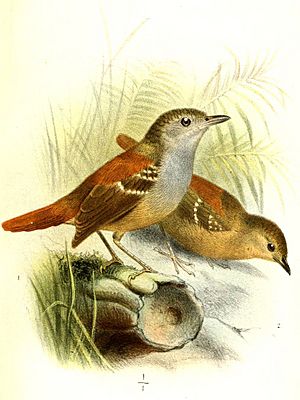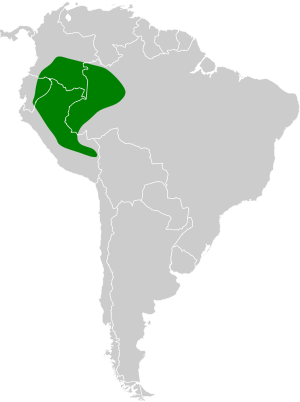Rufous-tailed stipplethroat facts for kids
Quick facts for kids Rufous-tailed stipplethroat |
|
|---|---|
 |
|
| Illustration by Joseph Smit, 1890 | |
| Conservation status | |
| Scientific classification | |
| Genus: |
Epinecrophylla
|
| Species: |
erythrura
|
| Subspecies | |
|
See text |
|
 |
|
| Synonyms | |
|
|
The rufous-tailed stipplethroat is a small bird that loves to eat insects. It's also called the rufous-tailed antwren. This bird belongs to a group of birds known as the antbird family. You can find it living in the warm, wet forests of countries like Brazil, Colombia, Ecuador, and Peru. Its natural home is in tropical lowland forests.
Contents
Understanding the Rufous-tailed Stipplethroat's Family Tree
Scientists like to organize living things into groups. This helps them understand how different species are related. The rufous-tailed stipplethroat was first described in 1890 by an English zoologist named Philip Sclater. He gave it the scientific name Hypocnemis erythrura.
Later, in 2006, scientists decided to place this bird in a new group, or genus, called Epinecrophylla. This is its current scientific name.
There are two main types, or subspecies, of the rufous-tailed stipplethroat:
- E. e. erythrura: This subspecies lives from southeastern Colombia down to northeastern Peru and northwestern Brazil.
- E. e. septentrionalis: You can find this subspecies in eastern Peru and the western part of the Amazon basin.
What Does the Rufous-tailed Stipplethroat Look Like?
This small bird is about 11.5 cm (4.5 in) long. It has a tail that is a bit longer than other birds in its group.
Male birds have olive-brown feathers on their upper bodies. Their back and tail are a pretty chestnut color. They also have pale tips on their wing feathers. The throat and chest of the male are gray, sometimes looking a bit "scaly." Their belly is olive-brown.
Female birds look similar to males. However, their throat and chest are a buff-ochre color, and their belly is a duller brown. Both male and female birds have red or orange eyes (called the iris) and a dark beak (called the bill). The male rufous-tailed stipplethroat is special because it's the only one in its genus without a brightly colored throat patch.
The female looks a bit like another bird called the rufous-backed stipplethroat. But the rufous-backed stipplethroat doesn't have chestnut colors on its back. When the rufous-tailed stipplethroat sings, it makes a high-pitched, squeaky sound.
Where Does the Rufous-tailed Stipplethroat Live?
The rufous-tailed stipplethroat lives only in the moist, warm forests of northern South America. This means it's an endemic species to this region.
You can find these birds in:
- Western Brazil
- Southeastern Colombia
- Eastern Ecuador
- Eastern Peru
They usually live in the lower and middle parts of the forest. They can be found at heights up to 700 m (2,300 ft) above sea level.
How the Rufous-tailed Stipplethroat Lives and Eats
The rufous-tailed stipplethroat often travels and eats in pairs or small groups. They sometimes join other small birds that are flying through the lower parts of the forest trees. These birds often look for food higher up in the trees than some of their relatives.
Their diet mainly consists of insects and spiders. They are very clever at finding food! They often probe into rolled-up leaves to find hidden bugs.
When it's time to build a nest, they create a dome-shaped home with an opening on the side. In Ecuador, these birds usually start breeding in February.
Is the Rufous-tailed Stipplethroat Safe?
Good news! The rufous-tailed stipplethroat is a fairly common bird. It also lives across a very large area. Its population seems to be staying strong.
Because of this, the International Union for Conservation of Nature (IUCN) has looked at its situation. They have decided that its conservation status is "least concern." This means scientists are not worried about this bird becoming endangered anytime soon.
See also
 In Spanish: Hormiguerito colirrufo para niños
In Spanish: Hormiguerito colirrufo para niños


